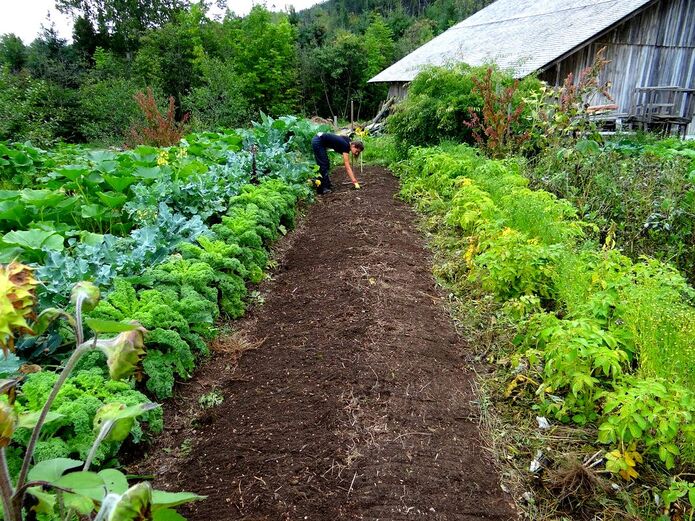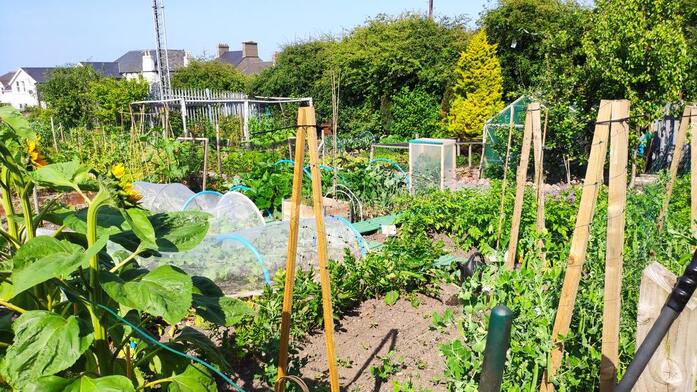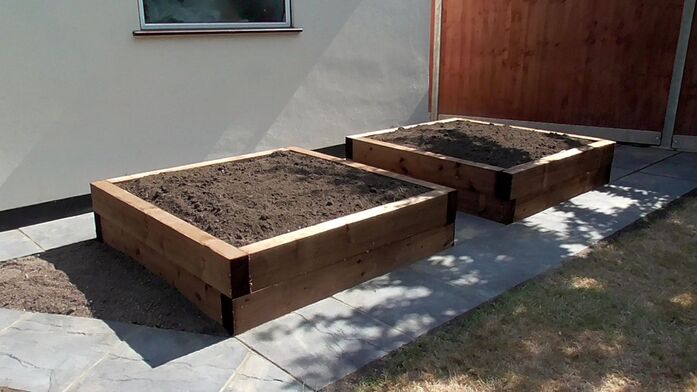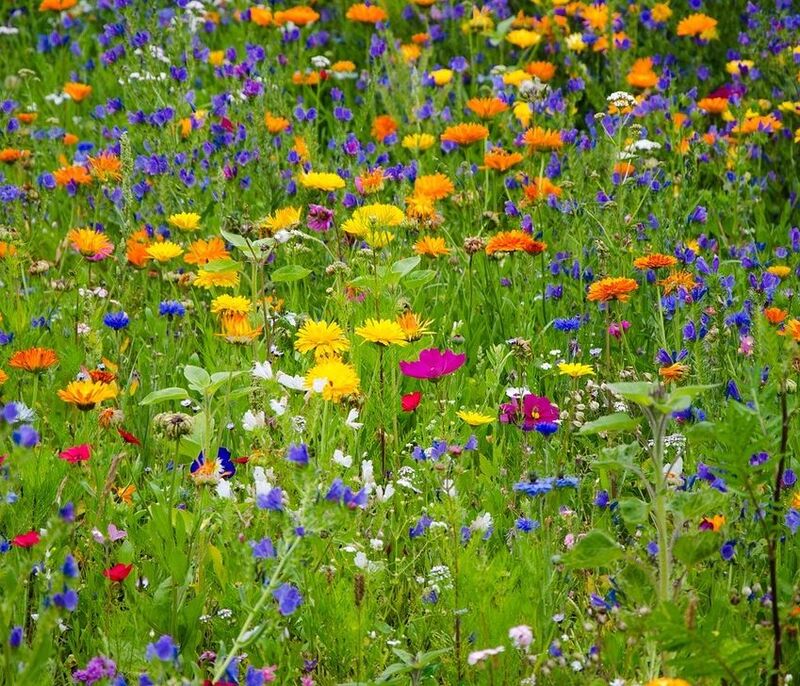|
This article contains affiliate links
Vegetable gardens can become a labour of love and all out passion. Many who dedicate their time to vegetable gardening are not just in it for the vegetables.
Vegetable gardeners have a love for interacting with nature and working with the soil. Very often however, vegetable gardens are rarely planned and landscaped well. Most vegetable garden landscaping is a combination of degrading planks filled with soil, upturned carpets and lawn. Such set ups are completely acceptable and affordable.
However, they do have their drawbacks and problems. Poor vegetable garden landscaping can lead to challenging maintenance and more pests.
By planning and landscaping your vegetable garden you can save money & many problems in the long run. Robust raised beds, hard wearing surfaces and a defined boundary can give you less work and more control. In this article I will list and summarise typical vegetable garden landscaping elements. What is the best vegetable garden layout?
The best vegetable garden layout will make perfect use of available sunlight and space while providing easy access, maintenance and harvesting. Typically the best layout will consist of rectangular beds easily reached from pathways without compacting soil. Pathways should be wide enough to enable easy access for wheelbarrows and other tools. Preferably beds will facilitate long, linear rows running from north to south. This will enable good sunlight coverage for your crops. Raised beds of varying heights can be implemented with the highest further away from the sun. This will help maximise light and exacerbate warm microclimates. When is the best month to build a vegetable garden?If you are planning on building a new vegetable garden the best time is late summer or autumn. If you leave it until spring you may miss out on valuable sowing and planting time. In Late summer you can landscape your new vegetable garden ready for the next season. If you try to do this in winter your site could turn into a boggy mess. Groundwork’s and levelsAn important consideration of a new vegetable garden is the ground levels. If your vegetable beds are on sloping ground you may find moisture and nutrients run to lower areas. This can lead to vegetables growing at inconsistent rates and at different sizes. In such circumstances vegetables at the top of slopes can become dry and bolt prematurely.
Therefore it is always advised to landscape vegetable gardens as level as possible. This is particularly the case with raised beds which may also be very well drained.
Consequently, it is advantageous to re-grade the whole surface of a new vegetable garden level. This will keep soil moisture levels consistent and make access easier. Drainage
Drainage is always a consideration when landscaping a new vegetable garden. Very often, there will be no need to install any drainage at all. However, if your locality has a high water table you may have a very boggy site. Such conditions can lead to compacted and stagnant soil which is challenging to work. In such cases you may wish to install a landscape drainage system. These traditionally consist of drainage channels with perforated pipes and free draining gravels. For more information on vegetable garden drainage read our comprehensive article here. Most of the time however, installing raised vegetable beds with free draining soil will solve this problem. Soil amelioration
There is probably nothing quite as fundamental for vegetables as having quality soil. Soil amelioration is typically an ongoing process which takes a number of years to perfect. If you are landscaping a new vegetable garden you will need a head start. Vegetable garden soil needs two main things; fertility and workability. If your soil is easy to work it will also be easy to weed, plant and harvest crops.
Therefore new vegetable beds will need to be turned over, tilled and worked to a friable texture.
The best way to stop soil particles sticking is by adding plenty of organic matter and grit. It is beneficial to mix in some well rotted manure 6 months before planting for added fertility. When landscaping a new vegetable garden it is good to buy in some compost rich topsoil in bulk. Raised beds
There are very few landscaped vegetable gardens that do not implement raised beds. Raised planters provide a deep and good quality growing medium for vegetables. This makes them a great choice especially for new vegetable gardens. Generally raised vegetable beds are built using, timber sleepers, concrete or bricks. As these structures must retain large volumes of heavy soil they must be robust. This is why I feel concrete and brick raised beds are always best as they last the longest. Timber sleepers are a more affordable option but will eventually degrade over time. Brick and concrete beds are more permanent but also more costly to install. Surfacing
Very often little attention is paid to surfacing around vegetable gardens. Access paths and working areas always benefit from a practical and robust wearing surface. These are best created out of solid materials instead of bark and loose gravels. Both the latter can become clogged with soil spillages over time. Therefore, it is best to install concrete or paved surfaces laid on a solid bed of mortar and pointed. Light colours will help to deter pests and reflect sunlight enhancing the local microclimate. Fencing
Conventional, boundary fencing is not always the best option for vegetable gardens. This is because it can shade out valuable sunlight from your growing areas. However, fencing off your vegetable garden from pests can be very beneficial. This can be particularly important if deer and rabbits can access your garden. If you have chickens you will also benefit from fencing as they will gladly nibble your greens. I find the best fencing is a 4 foot tall (1.2 metre) timber picket fencing with a gate. Alternatively agricultural stock fencing can also be very effective and doesn’t block out any light. Structures
Structures are a great way to make use of some extra sunlight on your site. Vegetables such as beans peas and trailing squash will happily make use of vertical support systems. Some of the best are trellis systems, arches and pergolas. If you are landscaping a vegetable garden such structures are an efficient use of space. Pergolas can be very effective at providing shady areas and look really good with hanging squash in autumn. If tall structures are positioned at the rear of your beds they will not shade out other crops. Greenhouse bases
If you are really serious about growing vegetables installing a greenhouse is a must. A greenhouse will enable you to start seeds early and harden off young plants gradually. Greenhouses and polytunnels can also be a fantastic way to grow more exotic fruits and vegetables. Greenhouses will typically need a solid concrete base to build upon. Therefore it is a good idea to plan its location before you start landscaping a vegetable garden. Compost systems
Composting and recycling nutrients is an important part of vegetable gardening. Vegetables will simply not reach their full potential without good soil nutrition and fertility. The best way to implement this is by building large composting bays. Many flimsy composters on the market only have capacity for organic kitchen waste. If you are landscaping a vegetable garden, larger composting bays have a much better capacity. The best scenario is to have three adjacent bays next to each other. Every year these can be shovelled from one bay to the other oxygenating the compost. Large composting bays can be easily installed using timber sleepers or concrete blocks. Ecology
Ecology may not be a typical consideration when landscaping a vegetable garden. However, ecological balance is recognised as being an effective strategy for pest control for crop growers. Small wildlife habitats can attract beneficial species to your growing areas and feed upon your pests. Unfortunately it is normally the most beneficial wildlife species which are most persecuted in gardens.
Some of these include spiders, wasps, hedgehogs, frogs, bats, reptiles and beneficial insects. The good news is these are easy to encourage back into our gardens with some simple installations.
Some of these include; ponds, meadows, deadwood, nesting boxes, hibernacula’s, native plants and rock piles. For more intensive information on how to make a garden wildlife area visit our full guide here.
'As an Amazon associate I earn from qualifying purchases'
2 Comments
3/22/2023 07:40:19 pm
I'm glad you talked that considering prioritizing ecology could be helped by using natural materials for your growing area. Yesterday, my father told us he was hoping to find a gravel supplies service that could transport aggregate and gravel for his farm property investment. He asked if I had any thoughts on the best plan to consider. I appreciate this instructive article. I'll tell him we can consult gravel service because they can provide information about their services.
Reply
7/18/2023 04:02:00 am
We have recently had to rescue a few client's vegetable gardens, as they had not properly considered the drainage issues you cover here. As you say, you can often get away with it, but we have had to dig out a few boggy carrots and start again.
Reply
Leave a Reply. |
The Author
|
Landscaping services across Buckinghamshire, Amersham, Aylesbury & High Wycombe
Hyde Heath, Amersham, Buckinghamshire |
|





















